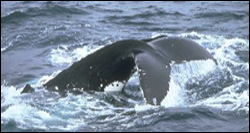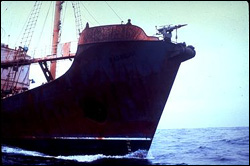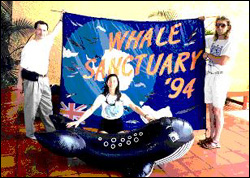ANTI-WHALING CAMPAIGN MISSION
To end whaling worldwide
Whales are incredible, intelligent animals whose numbers have been cruelly decimated by industrial whaling. Greenpeace Foundation is dedicated to an end to all whaling. It was a founder of the global anti-whaling movement, and has worked for three decades in this cause, seeking out, uncovering, and exposing the reality, cruelty – and often illegality – of whaling. Much has been accomplished, but the whales aren’t saved yet.
OVERVIEW
Whales are incredible, intelligent animals whose numbers have been cruelly decimated by industrial whaling. Greenpeace Foundation is dedicated to an end to all whaling. It was a founder of the global anti-whaling movement, and has worked for three decades in this cause, seeking out, uncovering, and exposing the reality, cruelty – and often illegality – of whaling. Much has been accomplished, but the whales aren’t saved yet.
FACTS
Since its inception in ’76, Greenpeace Foundation has helped lead the fight to “save the whales”. It has been a long and difficult fight, which has ranged from confronting the whalers on the high seas, to seeking them out where they illegally hide, to occupying their whaling ships. It has also involved decades of work to obtain moratoriums and help enforce treaties, as the world slowly embraced the conservation of whales.
We now have a global whaling moratorium in place, and a number of important areas of the world’s oceans have been declared sanctuaries for whales. It is illegal in many nations to hurt or harass a whale. Yet the whales are still under threat, and Japan has won support from many nations to permanently extend commercial whaling.
Japan is seeking permanent IWC whale-kill quotas by threatening to quit the IWC entirely, and this threat has garnered support from some conservationists who fear the carnage of Japan’s former practices. Whaling by Native Americans threatens to provide support for a new global category of unrestricted coastal non-subsistence whaling. And the number of whales “accidentally” caught in fishing nets in Japan has skyrocketed now that a whale is worth so much more than a cargo of fish. (Netted whales of any species are allowed by Japan to be sold in the market – often at caviar prices).
Japan and other whaling nations in its orbit have long advantage of a loophole in International Whaling Commission (IWC) rules to do “research” whaling, and then sell the whalemeat. Japan has been harpooning minke whales even within the Southern-ocean whale sanctuary.
More ominously, Japan – the world’s high-priced market for whale products – has been exposed as having conducting huge illegal imports of endangered whale meat; and DNA testing shows their markets still awash in the meat of “protected” whale species.
Greenpeace Foundation is a founding member of the Forensic DNA Alliance for Wildlife, a coalition of organizations using genetic techniques to help enforce the IWC’s whaling moratorium. In addition to funding the DNA sampling of whalemeat within Japan, it has called on Japan to immediately show its “whalemeat stockpiles” to international observers, and submit to IWC-verified DNA market testing. Add your voice to this cry!
In addition, Greenpeace Foundation is working for an end to the intentional take of whales in nets to circumvent IWC rules, which is fast becoming the largest global kill. We won’t stop our work until whales are assured of survival.
BACKGROUND
Since 1976, Greenpeace Foundation has seen the great whales as the clearest symbol of man’s destruction of the seas. These intelligent, social giants have in many cases been brought to the threshold of extinction by unrestrained whaling.
The killing itself is monstrous, with death times for the large whales ranging from 15 minutes to more than an hour after a whale has had a blunt harpoon driven into its intestines. The products produced are entirely unneeded: at this point whalemeat is a high-priced “novelty food” like caviar; in industrialized nations it is not eaten by poor people.
Today, despite numerous exposes of illegal whaling, the practice continues. While fewer whales are taken than in years past, in many cases this is simply because fewer whales are left to find.
Whales reproduce extremely slowly, and take a long time to mature. A “caviar” price on Japan’s black market drives opportunistic criminals around the world. Like illicit drugs, if there is a high-priced end market, someone WILL make the product available.
After the fall of the USSR, courageous Russian scientists produced the voluminous real data on Soviet whaling during the ’50’s, ’60’s, and ’70’s. The USSR and Japan had jointly conspired to wipe out most of the world’s large whales. More than 50,000 humpbacks, and similar high numbers of blue, fin, and right whales, were killed by the USSR and sold to Japan illegally. One may only wonder at the level of illegal kill which occurred during that period by Japan’s own whaling ships, because those controlling that end of the conspiracy were never exposed; and probably still control much of the industry. The distinction between business and government is very blurry in Japan, and in the case of whaling there has obviously been a longstanding complicity which continues to this day.
In 1977, campaigners of Greenpeace Foundation were the first conservationists to walk the bloody decks of a Soviet factory ship, during an at-sea confrontation and boarding. 550 feet in length, the seagoing slaughterhouse Dalniy Vostok could process a whale into small pieces in 20 minutes, and traveled with a contingent of up to 12 harpoon ships and a Japanese observer (ostensibly onboard to monitor compliance with IWC rules; but in retrospect just a meat inspector). Our crew not only halted the operations of this fleet for days, but the action spawned an ABC documentary and helped build momentum for a whaling ban. For the following two decades, Greenpeace Foundation has harried the whalers as it has focused world attention on Japanese and (formerly) Soviet whaling abuses.
Since 1986, a global moratorium on whaling has been in effect, and in 1994 a southern-ocean “whale sanctuary” was achieved. The Vostok whaling fleets have been scrapped. However, whaling nations have seldom been short on cynicism, and Japan has continued to kill hundreds of minke whales as “research” under a loophole in the charter of the 1946 International Convention for the Regulation of Whaling. Norway has also claimed a “research” kill quota. Many endangered whale species continue to show up in Japan’s marketplace, belying their “research” claims.
The world’s whalers – led by an unrepentant Japan – are undertaking a massive push to expand whaling again, and are becoming more sophisticated in their influence-trading and manipulations of data. At this point, science and investigative work – and the education of Japan’s people to the truth of history – are our best hopes to block the whalers’ brazen pro-whaling initiatives and stop the bloody whaling.





